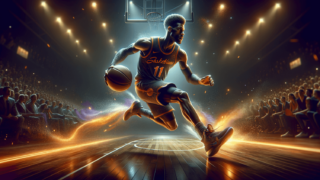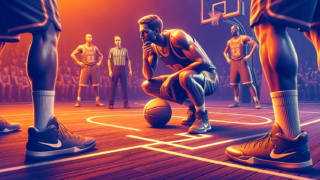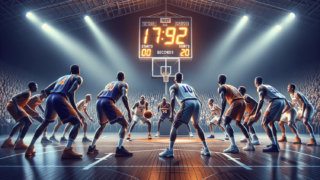
Endline Out of Bounds Rule in Basketball
Written by: Basketball Universe
Last updated:

Get ready, fellow hoopaholics, for an exciting exploration of one of basketball’s lesser-known intricacies: the endline out of bounds rule! In this exhilarating exposé, we’ll debunk any mysteries surrounding this aspect of the game, untangling the complexities and stylishly slam-dunking some invaluable knowledge on this fundamental rule. So, strap on your high-tops, and join us on the courts as we uncover the ins, outs, and everything in between about the endline out of bounds rule in basketball!
Endline Out of Bounds Rule in Basketball
The endline out of bounds rule in basketball occurs when a player in possession of the ball, or the ball itself, crosses the endline which marks the outer boundary of the court. When this happens, the opposing team gains possession and will inbound the ball from the nearest sideline, just beyond the endline. This rule applies to both offensive and defensive players and is designed to maintain the structure and flow of the game within the defined playing area.
Dribbling Towards Understanding Endline Out of Bounds Rule
Let’s begin with a step-by-step breakdown of some key elements and intricacies that paint a vivid picture of the endline out of bounds rule. By diving deeper into these related concepts, you’ll soon realize how this rule is interconnected with other basketball rules and scenarios that contribute to the game’s overall harmony.
Defining the Endline
The endlines, also known as baselines, define the width of a basketball court. They are the shorter boundaries, parallel to each other and perpendicular to the sidelines. The endlines connect the sides of the court and form the playing area along with the sidelines. It is crucial for players to be aware of these limits to avoid committing an out of bounds violation, which triggers the endline out of bounds rule.
The Inner Workings of the Out of Bounds Violation
Simply put, an out of bounds violation occurs when the ball, or a player with the ball, steps out of or touches the lines that mark the court’s boundaries. This includes the endlines, as the title of our blog suggests. In this section, we’ll dissect the different scenarios where endlines and out of bounds violations intertwine in the world of basketball rules.
Offensive Endline Out of Bounds
An offensive endline out of bounds situation surfaces when the team in possession of the ball commits a violation by stepping on or over the endline. This can happen as a result of taking a drive to the basket, attempting to secure a rebound, or mishandling a pass. Regardless of the reason, the outcome remains the same—the defensive team is awarded possession, tasked with inbounding the ball from the closest sideline.
Defensive Endline Out of Bounds
Meanwhile, a defensive endline out of bounds violation emerges when a player from the team without the ball crosses the endline. This could occur when the defensive player contests an offensive play, such as a shot attempt, or hustles to grab a loose ball. When this violation transpires, the offensive team retains possession and inbounds the ball from the nearest sideline.
Inbounding: The Art of Reintroducing the Ball
Once an endline out of bounds violation has been called, the game proceeds with the inbounding process. Let’s take a closer look at the responsibility that befalls the team awarded possession, from the positioning of players to the rules that govern these decisive inbound plays.
Gearing Up for an Inbound Pass
After the referee determines possession, the player tasked with inbounding the ball—typically a guard, although any available player can perform this duty—assumes their position on the sideline, just outside the boundary. The inbounder must remain stationary and has a set time frame (usually five seconds) to toss the ball back into play. Failure to comply with these guidelines would result in another out of bounds turnover.
Mastering the Art of Space Utilization
Inbounding requires strategic thought, positioning, and timing. Teams often develop specific plays to ensure the inbound pass is successful and advantageous in terms of scoring opportunities. Understanding how to use the space near the endline effectively can make all the difference. Players must consider off-the-ball movement, screens, and evading defenders to create openings and facilitate a successful inbound pass.
Endline Out of Bounds Rule and its Friendship with Shot Clock
As intriguing as the endline out of bounds rule may be, its partnership with the shot clock is equally captivating. This dynamic duo contributes to the rapid pace and excitement of the game, and understanding their relationship is crucial for a comprehensive knowledge of the sport.
Shot Clock Reset After an Endline Violation
When a team violates the endline out of bounds rule, the shot clock can either reset entirely, partially, or not at all. The decision depends on the specific violation moment and possession scenario. Reset rules have undergone changes over the years in leagues around the world, so it’s essential to keep up with the most current guidelines.
Time Crunch: A Critical Component of the Game
How the shot clock gets affected by an endline out of bounds violation exhibits the importance of understanding different basketball rules and their nuanced interactions. These interconnected rules dictate the pace and decision-making, enabling skilled players to leverage time and space management to their advantage on the court.
Key Differences in the Endline Out of Bounds Rule Across Basketball’s Various Leagues
Basketball rules, including the endline out of bounds rule, may vary slightly across different leagues and organizations worldwide. Let’s compare some distinctions between the NCAA, NBA, FIBA, and recreational leagues to shed light on these subtle nuances.
NCAA: College Hoops and Endline Out of Bounds
The NCAA governs collegiate basketball, and while their endline out of bounds rules align closely with the NBA, there are specific distinctions. One example involves the placement of the coaching box and team area along the sideline, which is closer to the endline compared to professional basketball. This placement can result in a slightly different inbounding experience for players, as well as unique strategies executed by coaching staffs.
NBA vs. FIBA: Out of Bounds and International Play
While the basic endline out of bounds rule remains constant, subtle differences arise between NBA and FIBA (International Basketball Federation) regulations. These variations can impact the dimensions of the court itself and key areas within the game, such as the three-point line and restricted area. Consequently, this impacts the tactical approach of the game, along with endline out of bounds defense, and offense and inbounding strategies.
Recreational Basketball: A More Relaxed Approach?
In recreational leagues or informal pickup games, rules can be slightly more lenient, or players may not adhere to strict enforcement like professional or organized basketball. However, the understanding and application of the endline out of bounds rule remain largely the same, ensuring a fair and enjoyable contest that stays true to the spirit of the sport.
As we’ve equipped you with more detailed knowledge on the ins and outs of the endline out of bounds rule in basketball, you’re now a more informed player or fan. Cherish this newfound enlightenment as you watch or play the game, and remember—basketball rules may change, but the love for this exhilarating sport remains unshakeable.
Enhancing Your Court Awareness
Now that we have a solid understanding of the endline out of bounds rule in basketball, let’s discuss ways to improve our spatial awareness on the court. Excelling at identifying and positioning oneself within the playing area is critical for avoiding violations and capitalizing on scoring opportunities. Let’s take a closer look at some methods to develop this essential facet of your game.
Physical Drills to Boost Spatial Awareness
Athletes can target their court awareness and spatial understanding through positional and movement-based drills. These exercises condition the body and mind to respond quicker and more effectively under game-like scenarios. Incorporate drills that emphasize the use of sidelines and endlines, as well as placing targets or markers within safe zones inside the boundaries. This will help acclimate athletes to the court’s dimensions and reduce endline out of bounds violations.
The Importance of Vision Training
One of the most significant aspects of enhancing court awareness is nurturing acute peripheral vision. Vision training exercises are designed to enhance a player’s ability to focus on objects and movements outside of their direct line of sight, allowing them to spot teammates, track defenders, and maintain a sense of the court’s boundaries. Engaging in vision training consistently can refine your court awareness, making you more adept at avoiding violation scenarios such as the endline out of bounds rule.
Adapting to Adversity: Playing Under Unique Conditions
While basketball is typically played indoors on a standard hardwood court, the sport’s versatility has contributed to its expansive growth and popularity worldwide. As a result, players frequently find themselves competing on diverse court surfaces and under various conditions. Let’s explore how adapting to these environments can further elevate your knowledge and application of rules like the endline out of bounds regulation.
Outdoor Courts and Varied Surfaces
Basketball is a global phenomenon, played on both indoor and outdoor courts. The surfaces of outdoor courts can be drastically different from hardwood, often made of concrete, asphalt, or even custom-built composite materials. The court dimensions may also slightly vary, as well as the visibility of endlines and sidelines. Familiarizing oneself and adapting to these distinct environments will make a player more versatile and prepared for any challenges they may face.
Weather Factors and their Impact on Gameplay
Outdoor games introduce a new layer of complexity—weather. Rainy or windy conditions can adversely affect both the court surface and ball handling. In such situations, maintaining court awareness and effectively implementing the endline out of bounds rule become even more essential. By practicing and playing under varied weather conditions, players can enhance their cognitive and physical adaptability, boosting their all-around game.
Embracing the Challenge of Multi-Sport Athletes
Basketball players who participate in multiple sports such as soccer, football, or even volleyball are often required to adapt to different field and court dimensions. In the spirit of becoming a more versatile athlete, let’s examine how engaging in diverse athletic activities can impact and benefit your court awareness and familiarity with rules such as the endline out of bounds.
Transferable Skills and Court Awareness
Engaging in various sports can contribute to the development of transferable skills that are applicable to multiple athletic environments. The process of adapting to different sports also helps athletes refine their peripheral vision and spatial awareness, allowing them to become more effective at avoiding out of bounds violations in basketball. Practice navigating other sports’ field dimensions and boundaries, and watch as these newfound skills translate seamlessly into your basketball game.
By embracing the challenge of multi-sport participation, you are not only honing your court awareness and rule adherence but also fostering the cultivation of a more balanced and well-rounded athlete.
Frequently Asked Questions: Endline Out of Bounds Rule
Beyond our in-depth exploration of the endline out of bounds rule, players and fans alike may still have lingering questions. Delve into this FAQ section answering some common queries about this basketball rule and related concepts, further clarifying any uncertainties and empowering your understanding of the topic.
1. What is considered out of bounds in basketball?
In basketball, a player or the ball is considered out of bounds when they touch the lines that mark the court’s boundaries—including the endlines and sidelines, or the area designated as out of bounds. When this occurs, the opposing team gains possession, and an inbound play is performed.
2. Can a player jump from out of bounds back into play?
A player cannot jump from out of bounds back into play while holding or touching the ball. To legally re-enter the court, the player must first establish positional contact with the court by placing both feet inbounds. Additionally, if they’re the first to touch the ball after returning, it’s considered a violation, and the opposing team gains possession.
3. Can you score from out of bounds?
No, a player cannot score a basket from out of bounds. If a player shoots the ball while standing out of bounds or touching the boundary lines, the shot is considered invalid, and the opposing team is awarded possession. The player must be inbounds for a shot attempt to count.
4. What happens if the ball hits the endline?
If the ball touches the endline and leaves the court, it is considered out of bounds. The opposing team is awarded possession and will inbound the ball from the nearest sideline, just beyond the endline.
5. How long does a player have to inbound the ball?
A player inbounding the ball typically has five seconds to pass it to a teammate on the court. If the player fails to complete the inbound pass within this time frame, the opposing team is awarded possession.
6. Can the inbounder score directly from an inbound pass?
No, the inbounder cannot score directly from an inbound pass. They must pass the ball to a teammate who is inbounds before a shot attempt can be made. If the inbounder attempts to score directly, it is considered a violation, and the opposing team gains possession.
7. What is the three-second rule in basketball?
The three-second rule states that an offensive player cannot remain in the painted area (also known as the key or the lane) for more than three consecutive seconds while their team is in possession of the ball. If this rule is violated, the opposing team gains possession as a result of a turnover.
8. What is the backcourt violation in basketball?
A backcourt violation occurs when an offensive player crosses the half-court line with the ball and then passes the ball back into their team’s backcourt without the ball being touched by a defensive player. The opposing team will gain possession due to this turnover.
9. Can a defensive player catch a missed shot attempt without it being considered an out of bounds violation?
A defensive player can catch a missed shot attempt without violating the endline out of bounds rule, as long as they maintain both feet inbounds and do not touch the endlines or sidelines while receiving the ball. This would result in a successful defensive rebound play.
10. Does the endline out of bounds rule apply the same way in 3-on-3 basketball?
Yes, the endline out of bounds rule applies similarly in 3-on-3 basketball. If a player or the ball goes out of bounds beyond the endlines, the opposing team gains possession and will inbound the ball at the designated checkpoint near the three-point line, specific to the 3-on-3 basketball variation.
Featured Posts
- No pillar pages found.





